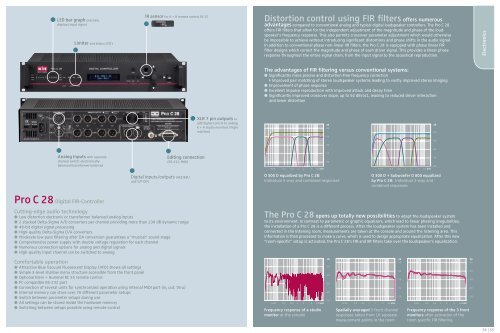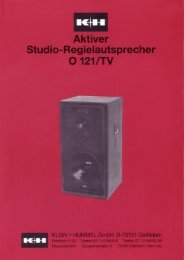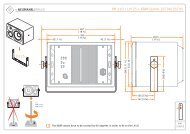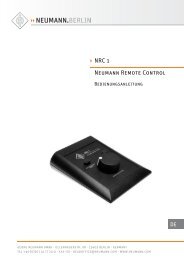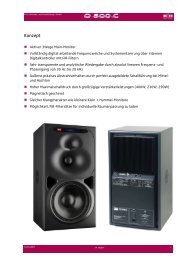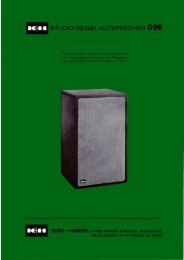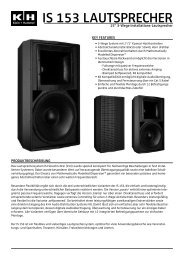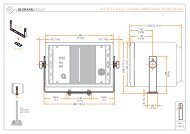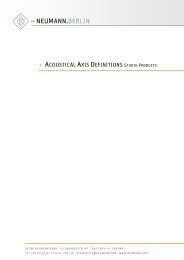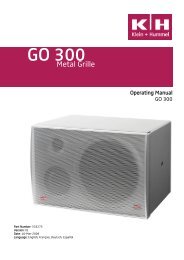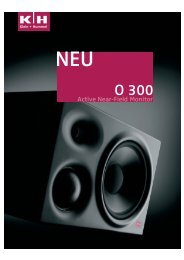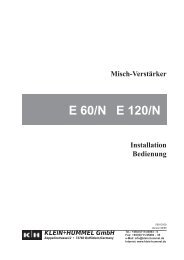Catalog - Klein + Hummel
Catalog - Klein + Hummel
Catalog - Klein + Hummel
You also want an ePaper? Increase the reach of your titles
YUMPU automatically turns print PDFs into web optimized ePapers that Google loves.
LED bar graph precisely<br />
displays input signal<br />
Limiter and status LED’s<br />
IR sensor for K + H remote control RC 55<br />
Distortion control using FIR filters offers numerous<br />
advantages compared to conventional analog and typical digital loudspeaker controllers. The Pro C 28<br />
offers FIR filters that allow for the independent adjustment of the magnitude and phase of the loudspeaker’s<br />
frequency response. This also permits crossover parameter adjustment which would otherwise<br />
be impossible to achieve without introducing significant distortions and phase shifts in the audio signal.<br />
In addition to conventional phase non-linear IIR filters, the Pro C 28 is equipped with phase linear FIR<br />
filter designs which correct the magnitude and phase of each driver signal. This provides a linear phase<br />
response throughout the entire signal chain, from the input signal to the acoustical reproduction.<br />
Electronics XXXXXXX Monitore<br />
The advantages of FIR filtering versus conventional systems:<br />
Q Significantly more precise and distortion-free frequency correction<br />
A Improved pair matching of stereo loudspeaker systems leading to vastly improved stereo imaging<br />
Q Improvement of phase response<br />
Q Excellent impulse reproduction with improved attack and decay time<br />
Q Significantly improved crossover slope, up to 92 dB/oct., leading to reduced driver interaction<br />
and lower distortion<br />
XLR 7 pin outputs to<br />
add digital control to analog<br />
K + H studio monitors (high/<br />
mid/low)<br />
dB<br />
– 40<br />
dB<br />
– 40<br />
– 50<br />
– 50<br />
– 60<br />
– 60<br />
Analog inputs with separate<br />
channel switch: electronicallybalanced/transformer-balanced<br />
Editing connection<br />
(RS-232, MIDI)<br />
0.05 0.2 0.5 1 2 5 10kHz<br />
– 70<br />
– 80<br />
– 70<br />
– 80<br />
0.05 0.2 0.5 1 2 5 10kHz<br />
Digital inputs/outputs (AES/EBU<br />
and S/P-DIF)<br />
O 300 D equalized by Pro C 28:<br />
Individual 3-way and combined responses<br />
O 300 D + Subwoofer O 800 equalized<br />
by Pro C 28: Individual 3-way and<br />
combined responses<br />
Pro C 28 Digital FIR-Controller<br />
Cutting-edge audio technology<br />
Q Low distortion electronic or transformer balanced analog inputs<br />
Q 2 stacked Delta-Sigma A/D converters per channel providing more than 130 dB dynamic range<br />
Q 48-bit digital signal processing<br />
Q High-quality Delta-Sigma D/A converters<br />
Q Moderate low pass filtering after DA conversion guarantees a “musical” sound stage<br />
Q Comprehensive power supply with double voltage regulation for each channel<br />
Q Numerous connection options for analog and digital signals<br />
Q High-quality input channel can be switched to analog<br />
The Pro C 28 opens up totally new possibilities to adapt the loudspeaker system<br />
to its environment. In contrast to parametric or graphic equalizers, which lead to linear phasing irregularities,<br />
the installation of a Pro C 28 is a different process. After the loudspeaker system has been installed and<br />
connected in the listening room, measurements are taken at the console and around the listening area. This<br />
information is then processed to make a curve, which is used to design appropriate equalization. After this new<br />
“room-specific” setup is activated, the Pro C 28’s FIR and IIR filters take over the loudspeaker‘s equalization.<br />
Comfortable operation<br />
Q Attractive Blue Vacuum Fluorescent Display (VFD) shows all settings<br />
Q Simple 3-level shallow menu structure accessible from the front panel<br />
Q Optional <strong>Klein</strong> + <strong>Hummel</strong> RC 55 remote control<br />
Q PC compatible RS-232 port<br />
Q Connection of several units for synchronized operation using internal MIDI port (in, out, thru)<br />
Q Internal memory can store over 70 different parameter setups<br />
Q Switch between parameter setups during use<br />
Q All settings can be stored inside the hardware memory<br />
Q Switching between setups possible using remote control<br />
– 70<br />
0.05 0.2 0.5 1 2 5 10kHz<br />
Frequency response of a studio<br />
monitor at the console<br />
dB<br />
– 30<br />
– 40<br />
– 50<br />
– 60<br />
0.05 0.2 0.5 1 2 5 10kHz<br />
Spatially averaged 3 front channel<br />
responses taken from 10 separate<br />
measurement points in the room<br />
dB<br />
– 30<br />
– 40<br />
– 50<br />
– 60<br />
– 70<br />
0.05 0.2 0.5 1 2 5 10kHz<br />
Frequency response of the 3 front<br />
monitors after activation of the<br />
room specific FIR filtering<br />
dB<br />
– 30<br />
– 40<br />
– 50<br />
– 60<br />
– 70<br />
54 | 55


